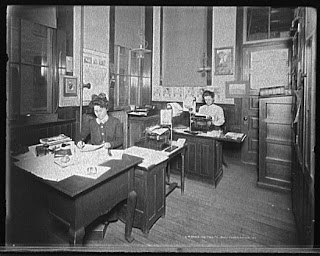 Women were employed in large numbers in Boston in 1905. Mas-sachusetts state census data from that year indicates that 41% of adult women were working, and in many categories of employment--some surprising, some not.
Women were employed in large numbers in Boston in 1905. Mas-sachusetts state census data from that year indicates that 41% of adult women were working, and in many categories of employment--some surprising, some not. Nearly 40% of working women worked in "Domestic and Personal Service" (and that of course does not count all the women who were "not gainfully employed" as housewives!) It's important to note that this category includes not only household servants, but also nurses, midwives, waiters, launderers, office cleaners, and boarding house keepers--all common women's work of the era.
Nearly 40% of working women worked in "Domestic and Personal Service" (and that of course does not count all the women who were "not gainfully employed" as housewives!) It's important to note that this category includes not only household servants, but also nurses, midwives, waiters, launderers, office cleaners, and boarding house keepers--all common women's work of the era.Another 28% worked in "Manufacturing and Mechanical Pursuits". Women formed the vast majority of sewing machine operators--making everything from men's shirts to ladies' dresses. They were also in the majority in the manufacture of clothing items (buttons, collars, cuffs, hosiery, lace, silk, and ladies' hats) and various household products (brooms and brushes, carpets, paper, paper boxes, books, candy, and canned meats and fruits.)

25% were employed in the "Trade and Transportation" category. This included women working throughout Boston's offices. Women constituted 89% of stenographers and typewriters, 71% of telephone and telegraph operators, 60% of bookkeepers and accountants, 20% of messengers and errand/office boys (!), 18% of clerks and copyists, and even 4% of "officials of banks and companies".

And 7% were employed in "Professional Service" jobs, which included such disparate professions as actress, clergy, doctor, journalist, lawyer, "literary or scientific person", musician, and teacher. Nearly 20% of Boston's doctors were women in 1905, as well as 80% of the city's teachers and professors.
Only a handful of women worked in the two remaining categories. 98 Boston women were engaged in "Agricultural Pursuits", mostly as farm laborers, and 310 women worked as apprentices, primarily in textiles.
Illustration Credits and References
Census data from Census of the the Commonwealth of Massachusetts, 1905. Volume 2: Occupations and Defective Social and Physical Conditions.
The photograph at the top of this post was taken in the stenographers' room at Leland & Faulconer Manufacturing in Detroit, a company that produced automobile engines and merged with Cadillac in 1905 (shortly after this picture was taken). Credit: Library of Congress, Prints and Photographs Division, Detroit Publishing Company Collection.
The photograph of the nurse is a Chicago Daily News photograph from 1905. Credit: DN-0002636, Chicago Daily News negatives collection, Chicago Historical Society.
The two office photographs were taken at National Cash Register in Dayton, Ohio by American landscape photographer WIlliam Henry Jackson in 1902. The first is a scene in the Indicator Department and the second from the Typewriting Department. Note the design of the workspaces, which featured lots of natural lighting and task lighting. Credit: Library of Congress, Prints and Photographs Division, Detroit Publishing Company Collection.
NOTE: NCR was founded in 1884, manufacturing the first mechanical cash registers. In 1906, they would introduce the first electric model. NCR still makes cash registers--among other things--only now they take the form of electronic point of sale systems, ATM machines, and check scanners!
1 comment:
North Bennet Street School Early Child Care - where Bobbie attended pre-school/daycare while I worked in Boston - was reputed to be the first child care establishment designed as a resource working mothers. The school itself was founded in 1885. Could be worth a look-see.
Post a Comment